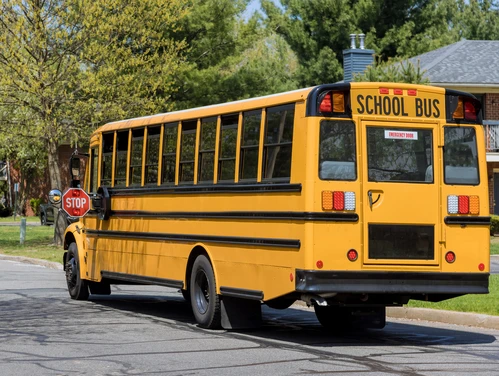With the start of the school year, a familiar sight is back in local communities. School buses, with their iconic yellow hues, have returned to Iowa’s neighborhood roads and busy highways to transport students safely each day.
Over 227,000 Iowa students depend on school bus transportation to attend daily classes. As a result of the high number of students who ride in buses, vans and other school vehicles, safety precautions are highly encouraged for schools, families and other drivers in the community.
“We have nearly 8,500 school buses and vehicles that will be on the road this year,” said Tom Simpson, state director for pupil transportation for the Iowa Department of Education. “Practicing caution while sharing the road as a driver or riding the bus as a student is important for everyone’s safety.”
Simple safety tips for other drivers in the community include watching for flashing lights that indicate the bus is slowing down and making a full stop when the stop sign arm is extended. Drivers should also be ready to adjust their speeds and be patient as school buses may make several stops. Simpson notes that driving safely can not only protect students who are getting on and off the bus, it can also save drivers from a traffic citation.
"Many school buses are equipped with exterior cameras that record school bus stop sign violations," Simpson said. "Troopers, county deputies and city police officers have found these cameras to be very helpful for educational and enforcement purposes. Keep children safe and avoid fines and possible license suspension by obeying the law and being extra cautious around school buses and students."
For students and families, an important safety tip includes avoiding standing in areas close to the bus, which are known as danger zones. Three times as many people are hurt while standing around the bus versus when riding in one. Students should also make sure they can see their driver and wait for them to indicate when it is safe to cross the street and load onto the bus.
“Don’t assume that just because you can see the bus that the bus driver can see you,” Simpson said. “Bus drivers have to watch for other drivers, tend to students and noise and navigate road conditions.”
For additional safety measures, schools are also required by the state to provide school bus training with students twice a year. The training covers what to do in an emergency and the procedure for evacuating a bus.
“For some students, it is their first time riding a bus,” Simpson said. “The school bus training helps to ensure they know what to do in an accident or emergency.”
Simpson encourages bus drivers, students, families and other community members to be on alert this school year, especially during the first few weeks of school.
“The first few days and weeks can be chaotic as everyone is excited and getting used to the routine of being back in school,” he said. “Whether you’re taking the bus, riding a bike or getting dropped off, be extra cautious – and courteous. There are a lot of distractions.”
Reminders for other drivers:
- When the bus’s yellow flashers turn on, that signifies that it is preparing to have a child get on or off the bus. All vehicles behind the bus must slow down and stay behind the bus, and then come to a complete stop when the red flashers turn on.
- If you are approaching a bus from the opposite direction, slow your speed to 20 mph when the bus turns on its yellow flashers.
- On a two-lane road, traffic in both directions must come to a full stop when the lights are flashing red.
- On a four-lane road, traffic moving in the opposite direction must slow down and proceed with caution when either red or yellow flashers are present. Traffic moving in the same direction must slow down and stay behind the bus when the yellow flashers are present, and then stop when the red flashers are present.
- Stop your vehicle at least 15 feet from the bus.
- Remain stopped until the flashing lights are turned off and the stop arm is pulled back in.
- Failure to comply can result in expensive fines, license suspension and even time in jail.
Reminders for students:
- Stop and look both ways before crossing a street.
- Make sure your bus driver can see you when you are crossing in front of the bus. If you can't see the driver, the driver can’t see you.
- Never cross behind the bus.
- When getting on or off the bus, never cross the street until the bus driver signals it’s OK to cross.
- If you drop something near the bus, do not pick it up. Instead, tell the bus driver what you dropped, and let the driver instruct you on what to do.
